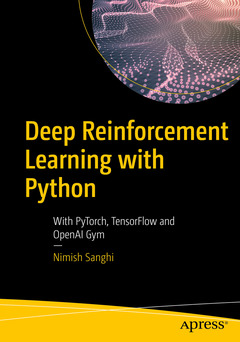Description
Deep Reinforcement Learning with Python, 1st ed.
With PyTorch, TensorFlow and OpenAI Gym
Author: Sanghi Nimish
Language: English
Subject for Deep Reinforcement Learning with Python:
382 p. · 17.8x25.4 cm · Paperback
Description
/li>Contents
/li>Biography
/li>Comment
/li>
- Examine deep reinforcement learning
- Implement deep learning algorithms using OpenAI?s Gym environment
- Code your own game playing agents for Atari using actor-critic algorithms
- Apply best practices for model building and algorithm training
Nimish is a passionate technical leader who brings to table extreme focus on use of technology for solving customer problems. He has over 25 years of work experience in the Software and Consulting. Nimish has held leadership roles with P&L responsibilities at PwC, IBM and Oracle. In 2006 he set out on his entrepreneurial journey in Software consulting at SOAIS with offices in Boston, Chicago and Bangalore. Today the firm provides Automation and Digital Transformation services to Fortune 100 companies helping them make the transition from on-premise applications to the cloud.
He is also an angel investor in the space of AI and Automation driven startups. He has co-founded Paybooks, a SaaS HR and Payroll platform for Indian market. He has also cofounded a Boston based startup which offers ZipperAgent and ZipperHQ, a suite of AI driven workflow and video marketing automation platforms. He currently hold the position as CTO and Chief Data Scientist for both these platforms.
Nimish has an MBA from Indian Institute of Management in Ahmedabad, India and a BS in Electrical Engineering from Indian Institute of Technology in Kanpur, India. He also holds multiple certifications in AI and Deep Learning.
Explains deep reinforcement learning implementation using TensorFlow, PyTorch and OpenAI Gym.
Covers deep reinforcement implementation using CNN and deep q-networks
Explains deep-q learning and policy gradient algorithms with in depth code exercise




